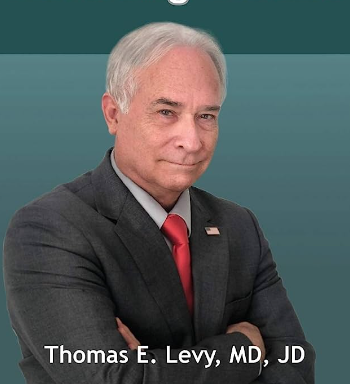
Dr. Thomas Levy's Comments on Vitamin C, Ozone, and Chronic Infections and Oxidative Stress
by Thomas Levy MD, JD
Thomas E. Levy, MD, JD is a board-certified cardiologist and author of several medical books, including "Curing the Incurable, Vitamin C, Infectious Disease and Toxins".
Dr. Thomas E. Levy presents at a Riordan Clinic symposium on the topic of treating chronic infections with vitamin C, magnesium, ozone and other potent natural remedies.
In a comprehensive video conference, Dr. Thomas Levy, a respected authority on health and wellness, shared profound insights into the role of Vitamin C and various other aspects that impact chronic diseases. His in-depth discussion spanned from achieving Vitamin C saturation, managing hormone balance, the unique challenge of Lyme disease to the limitations of traditional treatments and beyond.
The Fundamental Role of Vitamin C: Saturation and Therapeutic Application
Dr. Levy asserts the central role of Vitamin C in maintaining health, emphasizing the need to achieve a high concentration or "saturation" of Vitamin C in the body. This effect can be attained through consuming Vitamin C in various forms, with liposomal encapsulated Vitamin C being an excellent way to increase the intracellular delivery of the vitamin and enhance its concentration in immune-active cells.
An Integrated Approach: The Ascorbate Protocol, Additional Substances, and Hormone Balance
Dr Levy's "Ascorbate Protocol", combines Vitamin C with liposomal encapsulated Glutathione and Sodium Ascorbate powder. This combination neutralizes pathogens and toxins in the gut. IN addition to fat soluble ascorbate palmitate, other supplements included in his protocol are magnesium, vitamin K, vitamin D, and zinc to improve cellular wall stability.
It is important to maintain a normal thyroid function and hormone balance when controlling infections. He suggests that though hormonal adjustments may take time, they are paramount for long-term health maintenance.
Lyme Disease: Challenges, and Limitations of Traditional Treatments
Dr. Levy comments on the limitations of antibiotics which primarily work by chelating iron, which doesn't significantly impact the Lyme pathogen. He believes that resistance arises from the pathogen's ability to hide in immune cells enveloping within cyst-like biofilm structures. With Lyme disease his protocol also includes IV Vitamin C infusions. He has observed successful outcomes in 15 chronic Lyme patients with this approach. Early Lyme treatment with the addition of Vitamin C is important for more effective results, as the pathogen is accessible in the blood and extracellular fluid during the early stages.
The Redox Balance, Diagnostics, and the Role of Oxidized Species in Chronic Diseases
In the case of long-term infections like Lyme, Dr. Levy points out the persistent shift towards the oxidative side of the redox balance, leads to illness. To counter this, he suggests a treatment protocol that restores the reduction side of this balance, a role Vitamin C plays effectively. Glutathione, also given in liposomal form helps facilitate this reductive state, in chronic diseases.
Accurate diagnosis of Lyme is difficult through laboratory tests. With the ascorbate protocol, the patient's wellness becomes the primary indicator of effectiveness.
Chronic Degenerative Diseases and Focal Infections
Dr. Levy elaborates on infectious and toxic components in chronic degenerative diseases and the persistent oxidative stress they cause. He mentions a case study linking Rheumatoid arthritis to chronic streptococcal infection, critiquing specialized medicine for not considering such connections. Critiquing prevailing medical views on chronic illnesses he underscores the predominance of focal infections in chronic diseases and the primary sites of such infections. He emphasises addressing undiagnosed focal infections as serious culprits as a key source of chronic oxidative condition.
Useful Adjunct Therapies, Herxheimers and other Oxidants
Towards the end of the conference, Dr. Levy introduces additional therapies like DMSO (dimethyl sulfoxide), ozone therapy, hyperbaric oxygen therapy, ultraviolet blood irradiation, and intravenous hydrogen, discussing their similar effects and mechanisms. However, he warns of potential detox reactions and contraindications of these treatments.
He stresses the beneficial effects of magnesium chloride, which acts as a natural calcium antagonist and can decrease all-cause mortality. Lastly, he cautions consumers about potential toxicity and non-bioavailability of nutrients like metallic iron filings in enriched cereal.
